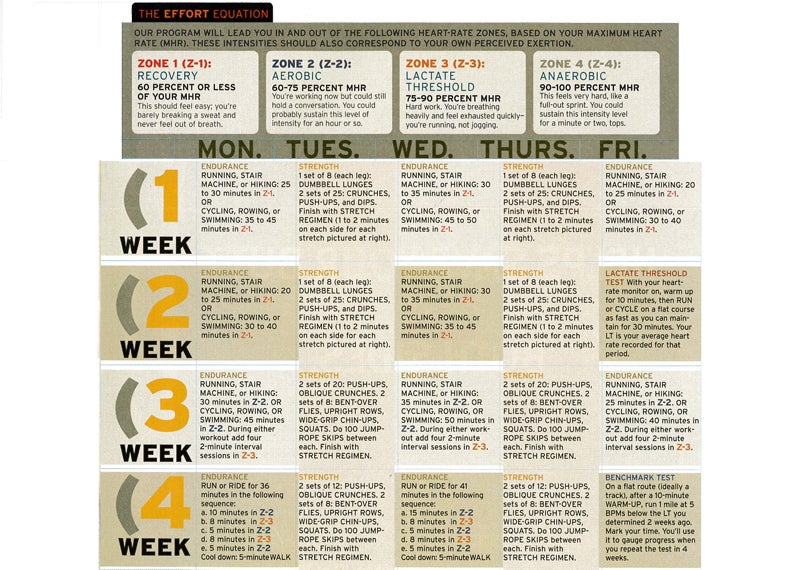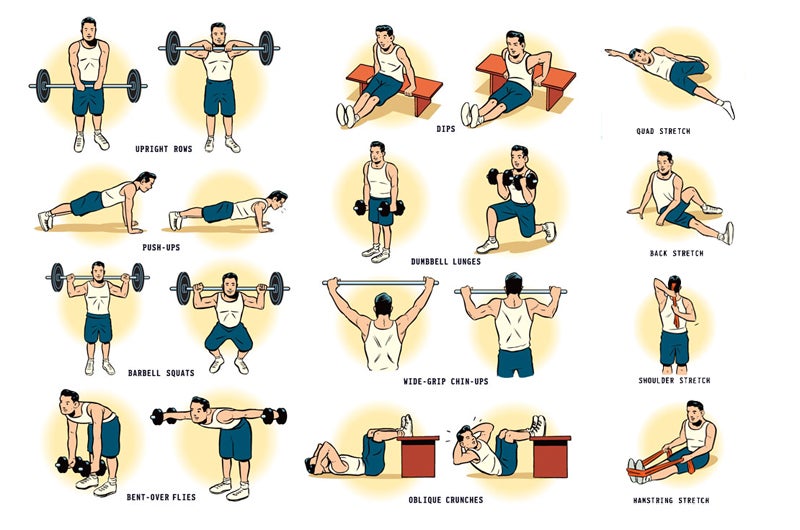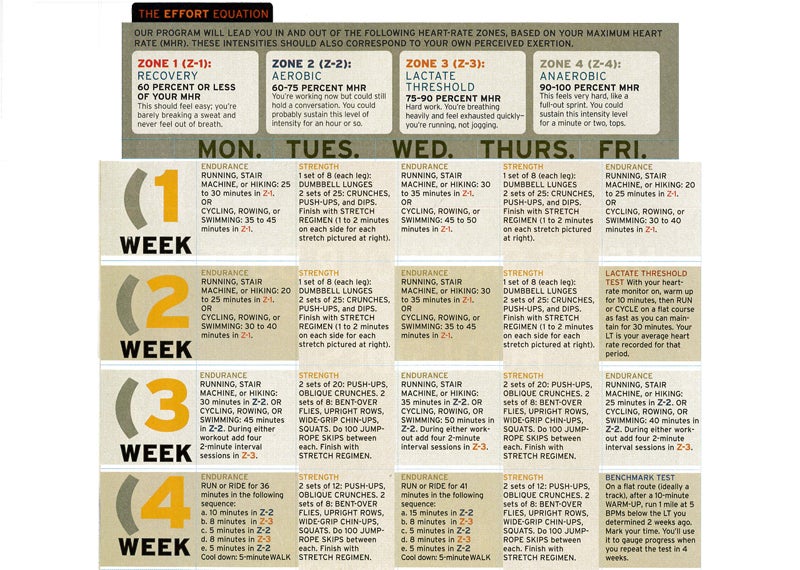A sustainable approach to exercise is tricky business because when it comes to fitness, we are all pilgrims stumbling toward the light. Everyone seems to have a vague idea about what they need to do to get in shape, and stay in shape, but that doesn't mean they know what to do about it. According to the research firm American Sports Data, 60 percent of Americans say exercise is good, yet they never exercise.
The five-month Shape of Your Life program has a solution. The first month, presented here, showcases enduranceÔÇöboth physical and motivational. It's the easiest month in terms of sheer volume, intensity, and complexity of the exercises, but it's essential because our endurance prescription is designed to get you in the habit of working out regularly, establish your baseline, and identify fitness goals. You'll also steadily increase your time commitment from about 30 minutes to an hour a day, five days a week. Subsequent months won't increase the duration of your workouts, but will ramp up the intensity and vary the exercises.
The Dynamic Master Plan
There's plenty of research focused on helping elite athletes optimize, and stick with, their training, but what most of us need is advice on how to fold fitness into a life not sponsored by a power drink. This begins with some rigorous introspection. Why get fit in the first place? What's the point? There are the superficial reasons. Guilt after a physical. Panic over, say, an impending surf trip. Ego. Vanity. Better reasons include the intrinsic value of exercise: how it can help stave off disease; how it stimulates the brain's production of serotonin, a natural mood-booster; how it keeps energy up and blood pressure and appetite down.
But the real answer is more simple and obvious. Getting in shape is nothing moreÔÇöand nothing lessÔÇöthan a means to an end. You can take off on a surf safari with dignity intact, run a half-marathon with your spouse and not seek couples counseling afterward, or ski black-diamond runs, fast, without sacrificing an ACL to the cause. You'll find troubleshooting tips, but the general wisdom is this: nail down a goal and you've found the wellspring of motivation, the fountain of fit.
Which is all well and good as long as you also have some solid infrastructure that will accommodate the day-to-day logistics of an ostensibly lifelong exercise plan. ConvenienceÔÇöor, rather, inconvenienceÔÇöis a tremendous gumption trap. “Have a training regimen for every environment you find yourself in,” says Ed Jackowski, author of┬áEscape Your Shape┬áand owner of Exude Fitness in New York. “When you can't make it to the gym after work, you have to have something you can do at home.”
Got a spare room? A basement? A backyard? Consider turning an unused space into a low-tech home gym. The Shape of Your Life requires only a few pieces of basic equipmentÔÇöa bench, dumbbells, a stability ball (also called a physio or Swiss ball), a new jump rope, and a plyometric boxÔÇöthat shouldn't run you more than $200. (You can even improvise: milk jugs for dumbbells, a stairs, a bench, or bleachers for the plyo box.) This modest tool kit is all you need to do brief-but-intense resistance training, ├á la Bill Phillips's┬á, the best-selling exercise book that seemed to have everyone who followed it looking like Joe Piscopo in a mere 12 weeks. You may not be after the freakish physique of a bodybuilder (if you're like me, the thought of waxing your chest gives you chills), but reams of research and fitness experts from coast to coast tout the benefits of lifting weights.
Next, you need a strategy, and nothing has proven itself more effective than the concept of periodizationÔÇöcyclic bouts of expansion and retrenchment designed to build fitness. By following a specifically staggered schedule you give your body a chance to regenerate enough to spring forward a few days later. After all, your muscles, and the capillaries that transport blood to fuel them, grow during rest, not during exertion. Simply alternating cardio and strength days, while important, is not enough. As a diagram, periodization might look something like those blocky steps and valleys you see on preset treadmill programsÔÇögo hard, ease off; go hardest, ease off; go hard; ease off. The popular training programs developed by┬áÔÇöauthor of┬áThe Mountain Biker's Training Bible╠ř▓╣▓ď╗ň╠řThe Triathlete's Training BibleÔÇöpresent a monthly workout schedule in which the third week is the hardest of the four. The key is to create a program with multiple layers of periodization, taking the staggered approach within each workout, each week, each month, and ultimately through the duration of your program. “Periodization is the most likely way to achieve athletic success,” says Friel.
Endurance 101
Endurance is the foundation of The Shape of Your Life because this workout plan is about going placesÔÇöthe top of Mount Washington, three weeks down the Back River, the finish line of 24 Hours of Moab. Technically, endurance is a combination of efficiency (lean body mass), physiology (a dense network of mitochondria that produces energy in the muscles), genes (a high percentage of slow-twitch muscle fibers), plumbing (an efficient heart capable of moving more blood per pump), and strength in those areas that help transfer force between the upper and lower body (the hips, lower back, abdominals, and other core muscles).
How do you build endurance? First, you need to put in steady, sustained periods of activityÔÇörunning, biking, swimming, rowingÔÇöat moderate intensity to build your muscular and aerobic base. “If you're always running out of gas after an hour, that can be indicative of not enough foundation,” says Ray Browning, seven-time Ironman winner and coauthor of┬á. “In some sports, like cross-country skiing and cycling, it can be easy to always work at too high an intensity and never develop your low-intensity base of endurance.” But base-building workouts in tandem with intensity training can bring about significant leaps in aerobic efficiency.
Brace yourselfÔÇöhere comes the lesson from Exercise Physiology 101. As intensity increases from moderate to high to very high (think jogging, running, sprinting), you compromise your body's ability to produce the energy needed to power muscle contraction. You can sustain a very high level of effort for brief periods because you've crossed your lactate threshold. (Lactate is a byproduct of lactic acid that can't be burned as fuel.) At this point, you shift from aerobic (oxygen-aided) energy production to anaerobic (non-oxygen-aided) energy production, and lactic acid is pouring into your muscles in such large amountsÔÇöhence the burnÔÇöthat they shut down. With proper conditioning, you can push this threshold back.┬á
To lift your LT, you first need to find out where it isÔÇöeasily done, thanks to the development of wireless heart-rate monitorsÔÇöand run an interval now and then close to that number. You can estimate your LT using a simple calculation that approximates your maximum heart rate (see “The Prime Rate,” last page), the highest number of times your chest ham can go flippity-flip in one minute. Your MHR isn't a direct indication of how fit you are, and it will vary from sport to sport. But this number is invaluable because the body marshals its different energy systems at various percentages of maximum heart rate with remarkable consistency. At 70 percent of MHR, it uses oxygen to burn fat; at 85 percent it begins breaking down muscles for fuel; and at 90 percent it burns carbs exclusively. Not many athletes can surpass 90 percent of MHR without hitting the lactate wall, when muscle contractionÔÇöand therefore youÔÇögrind to a halt. Depending on your fitness level, your own LT lives somewhere between the 75 and 90 percent mark.
The first month of The Shape of Your Life dedicates three days a week to aerobic and LT training. These sessions will repeatedly push your LT by way of intensity drillsÔÇöwhat you've probably come to know as intervals. At the end of each month, you'll gauge your progress with an easy time trial. As you find yourself running a mile faster at the same heat rate, you'll know you have a bigger engine and a higher tolerance for lactic acid. Congrats. You now have more than a running routine; you have endurance.

Building Better Muscles
Strength trainingÔÇöor, as it's now commonly called, resistance trainingÔÇöis on a tear. More research papers were published on the science of resistance training in the decade after 1987 than in all the years prior. Ever since the mushrooming interest in aerobic conditioning in the 1970s, studies have shown that, among other things, the upper bodies of elite runners who did not lift weights atrophied at the same pace as those of nonathletes, that weight lifting helped burn fat by raising resting metabolic rate, and that it offset the effects of aging by stimulating the production of human growth hormone. Studies on “core strength” make up the latest chapter in the story.
“The core is the seat of all power,” says Al Vermeil, strength and conditioning consultant for the Chicago Bulls. “Studies have shown that when you sit down to do a lift at a machine, you remove all the stabilizers, the neglected smaller muscles that don't move as much weight but keep you supported, connect your upper and lower body, and keep your joints in position. These are the hips, back, gluteus maximus, and lower abdominal muscles.
While strength is the theme during month two of The Shape of Your Life, the plan incorporates basic muscle-building drills from the first month: push-ups, sit-ups, pull-ups, lunges, bent-over lifts, and others. We've tried to streamline your workload in a few of them. Twisting the sit-up at the top adds a rotational component to the exercise. Doing a wide-grip pull-up transfers the work from your biceps (they look nice, but big bi's are only bit players in most sports) to your back. “Simplicity of tools, but complexity of use,” says Vermeil. “You can do everything you need with a medicine ball, dumbbells, a Swiss ball, and your own body weight. I used to train guys entirely with things we found in the woods.”
Ultimately, the variety of resistance training that you'll encounter here will do more than make you balanced and powerful. It will introduce strength work as a part of holistic conditioning, encouraging you to approach the weight stack not as a way to get buffÔÇöwhich is both impractical and unsustainableÔÇöbut as a way to make strength a permanent, functional part of your life.
The Big Picture
Excercise plans tend to be conspicuously lopsided. When I cavalierly leapt into my fit-a-thon a few years ago, I saw only one thing: me, ripped, on a board, cutting frontside arcs on a four-foot North Atlantic swell. Rest was for sissies. Don't even get me started on yoga.
I'm different now. Enlightened. My Shape of Your Life odyssey revealed nothing if not the understanding that lasting fitness and a resilient, balanced musculature depend on more than weights, running, and a sensible diet. Of equal if not greater import are mindfulness and flexibility. We delve fully into flexibility by way of yoga during the third month. Why yoga? Not only has it gone mainstreamÔÇö15 million Americans, including the Denver Broncos and the New York Giants, now practice yoga, up from six million eight years agoÔÇöbut an expanding body of research touts the importance of the mind-body connection.
“People probably have a genetic set point for flexibility,” says Ed Laskowski, codirector of the┬á. But that set point may be unrealized by some. Laskowski recently led a study that found the range of motion among those who suffered from chronically tight muscles changed significantly under anesthesia. “It might not be the muscles which are tight, but something about the nerves energizing the muscles,” says Laskowski. “If people learned how to relax mentally, that might improve their flexibility.”
This is where we come in. In the first month, The Shape of Your Life introduces traditional, one-minute postworkout static stretches to aid your recovery. During month three, we'll add dynamic power-yoga movements to help increase your core strength and flexibility, andÔÇöperhaps the most enduring asset of yogaÔÇöfine-tune your ability to monitor and adjust mental and muscular tension.
The final two months of the program are devoted to speed and power, balance and agility. We'll max out the intensity during the fourth month, then turn you on to some multipurpose dexterity training during the concluding four weeks.
And there you have it: endurance, strength, flexibility, speed and power, balance and agilityÔÇöthe building blocks for The Shape of Your Life. Mix in a few cups of nutrition, sprinkle on some motivational tips, add a dash of how-to, and serve on a bed of fun and adventure.
Had I known all this three years ago, who knows what I might have checked off my wish list by now. A surfing safari in Indonesia? Climbing Mount Rainier? Mountain biking across Chile? (We can all dream.) Hell, I might even have my original wedding ring. Which leads me to my final admonition: Look forward, not back. Put our plan in motion and see it through to the end. When you've reached that end, head out on the grandest adventure you can dream up. I can assure you of one thing: You'll be ready for it.
Start It Up: Month One Workout

This Installment of The Shape of Your Life is devoted to building endurance. This weekday plan (use your weekends for hiking, biking, running, climbing, paddling, whatever) utilizes heart-rate training zones to raise your VO2 max and lactate threshold (see above).
You need to round up a heart-rate monitor, but for the first two weeks, to get familiar with how your HRM works, just wear the unit and mentally note your digits during the aerobic sessions. At the end of week two, you'll determine your personal lactate threshold with a simple test. The interval sessions in weeks three and four are engineered to raise your LT.
We also introduce you to basic strength and flexibility training (see sidebar). For dumbbell lifts, use enough weight to bring you just short of exhaustion in each set. If you struggle with pull-ups, have a partner hoist you at the waist, or get friendly with the weight-assisted pull-up machine at your gym.
Begin each strength session with a warm-up (ten minutes of rope skipping, stair stepping, easy jogging, or zero-resistance cycling) and end with the stretch sequence. As always, if you have health concerns, consult your physician before starting this or any other exercise program. Finally, should you miss a workout, don't panic, just pick the workout back up as soon as you can.

Maximize Your Heart-Rate Training
Heart-rate training is the key to gauging your aerobic intensity and building endurance. Here's how to get started.
- Buy a Heart-Rate Monitor (HRM): In order to get the most out of the interval training used in The Shape of Your Life program, a midlevel HRM that can calculate average heart rate and provide target-zone programming with an audible alarm will be the most effective. With those functions, you'll be able to bump into higher and lower heart-rate zones (see step 3, below) without looking at the watch face. Models we like are created by Acumen, Cardiosport, and Polar.
- Calculate Your Maximum Heart Rate (MHR): Your MHR will determine the numbers that define your training zones. Use the following formula to determine your baseline MHR.
217 – (your age x 0.85) = MHR (in beats per minute)
Example: If you're 35, that comes out to 217 – 30 = 187 bpm. For rowing, subtract another 3 bpm. For cycling, subtract another 5 bpm. For swimming, subtract another 14 bpm. - Establish Your Four Heart-Rate Zones: A little more math and you're done. Using your MHR as a baseline, write down the corresponding heart rates for the following zones: recovery (60 percent of your MHR); aerobic (60-75 percent of MHR); lactate threshold, or LT (75-90 percent of MHR); and anaerobic (90 percent of MHR and above). You'll use these numbers to work out at prescribed intensities during each month's regimen.
Individual lactate thresholds vary widely among athletes. If you've let fitness slip for a while, your LT probably falls at the low end of Zone 3 (maybe 75 to 80 percent of MHR); if you're in good shape already, LT may hover closer to 80 or 85 percent. On Friday of week two of The Shape of Your Life program, you'll perform a workout designed to determine your LT more accurately for the upcoming intervals. At the end of each month you'll take a one-mile LT test to see if you've pushed it back.
with the first installment in our interactive training plan.


